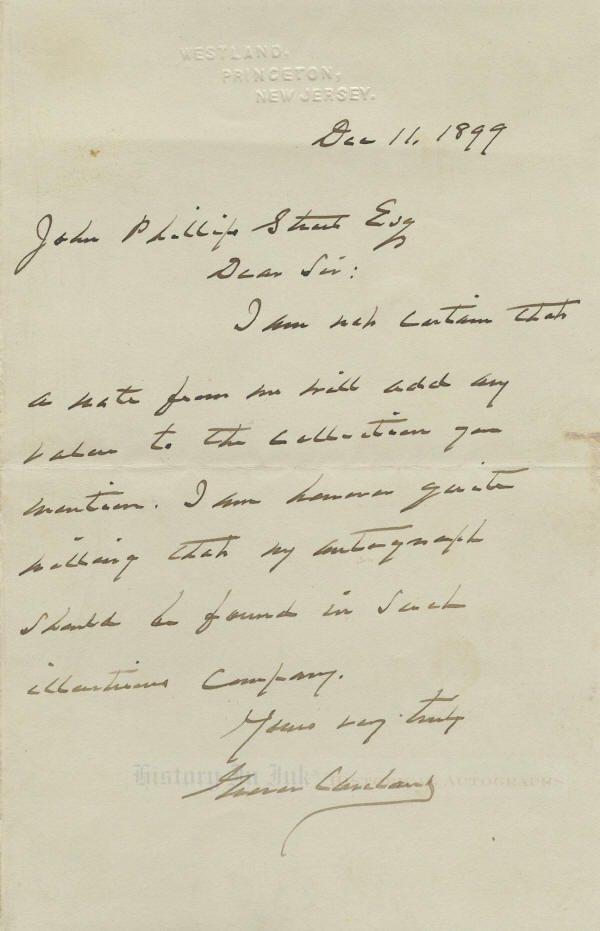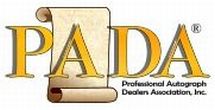1918801
Grover Cleveland
Scroll down to see images of the item below the description
“I am . . . quite willing that my autograph should be found in such illustrious company.”
Stephen Grover Cleveland, 1837–1908. 22nd President of the United States, 1885–1889; 24th President of the United States, 1893–1897. Autograph Letter Signed, Grover Cleveland, one page, 4¼” x 6¾”, on blind-embossed stationery of Westland, Princeton, New Jersey, December 11, 1899
In this polite letter, the former President sends his autograph. He writes: “I am not certain that a note from me will add any value to the collection you mention. I am however quite willing that my autograph should be found in such illustrious company.”
Despite his modesty, Cleveland was, and remains, the only person ever to serve two non-consecutive terms as President. A lawyer, Cleveland was known for his uncompromising attitude toward the public trust. As a reformer, he eschewed political expediency in order to do what he thought was right. The public responded to his integrity by launching him on a meteoric rise: Within three years, he was elected mayor of Buffalo, Governor of New York, and, in 1884, President of the United States.
As President, Cleveland vigorously used his veto to bar special favors for any particular group. Vetoing a bill to appropriate $10,000 to distribute seed grain among drought-stricken Texas farmers, he wrote that “Federal aid in such cases encourages the expectation of paternal care on the part of the Government and weakens the sturdiness of our national character.” He also vetoed hundreds of private pension bills to Civil War veterans whose claims were fraudulent. When Congress, pressured by the Grand Army of the Republic, the Union veterans’ organization, passed a bill granting pensions for disabilities not caused by military service, Cleveland vetoed that as well.
Cleveland angered the railroads by ordering an investigation of western lands they held by Government grant, forcing them to return 81,000,000 acres. He also signed the Interstate Commerce Act, the first law attempting federal regulation of the railroads. When railroad strikers in Chicago violated a court injunction, Cleveland sent federal troops to enforce it, because it affected the mails: “If it takes the entire army and navy of the United States to deliver a postcard in Chicago,” he thundered, “that card will be delivered.”
In December 1887, Cleveland asked Congress to reduce high protective tariffs. Although he handed the Republicans an effective issue for the 1888 presidential campaign, he said, “What is the use of being elected or reelected unless you stand for something?”
Cleveland, who was only the second post-Civil War president who had not served in the Union army, lost the presidency to Benjamin Harrison, a former Union brevet brigadier general, in 1888. Cleveland actually won the popular vote by 100,000 votes but lost the electoral vote 233 to 168. Four years later, Cleveland was reelected for a second term, the only President to serve two non-consecutive terms.
Shortly after Cleveland was inaugurated, panic struck the stock market, and Cleveland faced a severe economic depression. He dealt directly with the Treasury crisis rather than with business failures, farm mortgage foreclosures, and unemployment, obtaining repeal of the mildly inflationary Sherman Silver Purchase Act and, with the aid of J. P. Morgan and Wall Street, maintaining the Treasury’s gold reserve. Critics accused him of being unfeeling and heartless, but Cleveland believed that he had to keep the nation’s finances sound. His critics seized control of the Democratic party in 1896, repudiated his administration, and nominated William Jennings Bryan on a silver platform. Cleveland, who did not seek reelection himself, supported a third-party gold standard ticket that managed only 100,000 votes in the general election.
This one-page letter is ideal for framing. Cleveland has written and signed it in black fountain pen. The letter has one horizontal mailing fold, and there is a light horizontal crease just below the date. The integral leaf has been removed. There is a small stain on the right edge of the paper and a tiny stain in the blank area above the text, where there are also scattered minute foxing spots. None of these affect either the text or the signature. Overall the letter is in fine condition.
Unframed. Click here for information about custom framing this piece.
This item has been sold.








